Had fun in the sun and now your skin is burned? Do you deal with irritating skin conditions such as acne, psoriasis, or eczema? Are you constipated or have digestive issues? What about dental plaque? Do you have buildup?
The list could go on, but let’s pause here and give a grand and beautiful solution that may help alleviate many of these issues for you … Aloe vera!
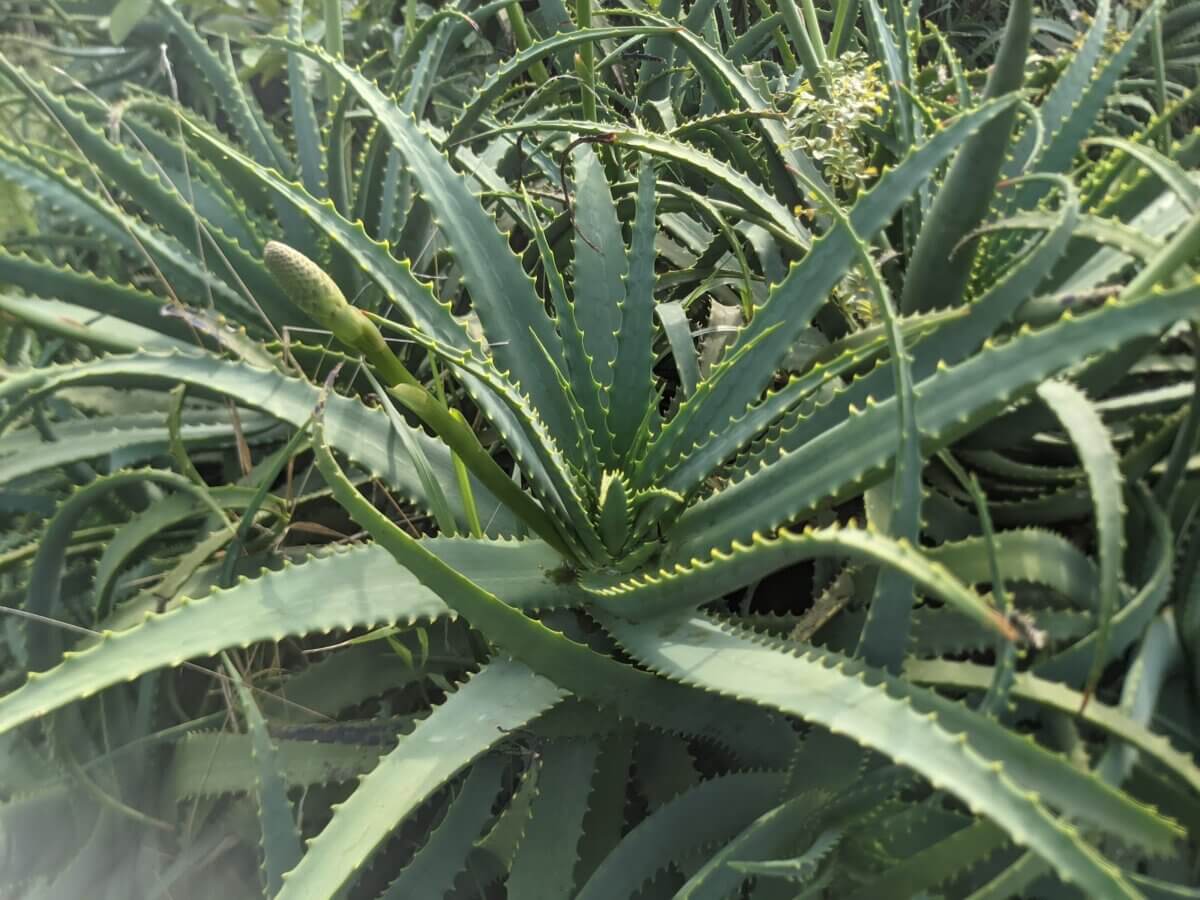
Aloe vera is a popular and cherished plant for a variety of reasons. There are many medicinal uses of this plant with the most common and well-known being a relief for sunburnt skin. Aloe vera is also aesthetically pleasing, and many like to have it around to admire. Its plump leaves (that range from spotted yellow all the way to dark green) are beautiful, and the flower stalks that Aloe vera produces are equally mesmerizing. Not to mention, it’s easy to grow indoors and out with its size varying according to the container it’s growing in.
Many are unaware of Aloe vera’s uses and benefits outside of sunburn topical gel, and equally unaware of how to harvest this gel in order to use it.
Ethical harvest is the most important part of this article, and the first step in this process. Let’s start there.
Ethical Aloe Vera Harvesting
What Is Ethical Harvesting?
This term means that the plant (regardless of species) is being harvested in a responsible and sustainable way, which often means the environmental impacts are next to none, or minimized as much as possible. For the purposes of this topic, it means the plant undergoes as little harm as possible from the process of harvesting, and therefore, is ensured to live on and keep thriving after the fact. After all, you can’t keep harvesting Aloe vera gel if the plant dies.
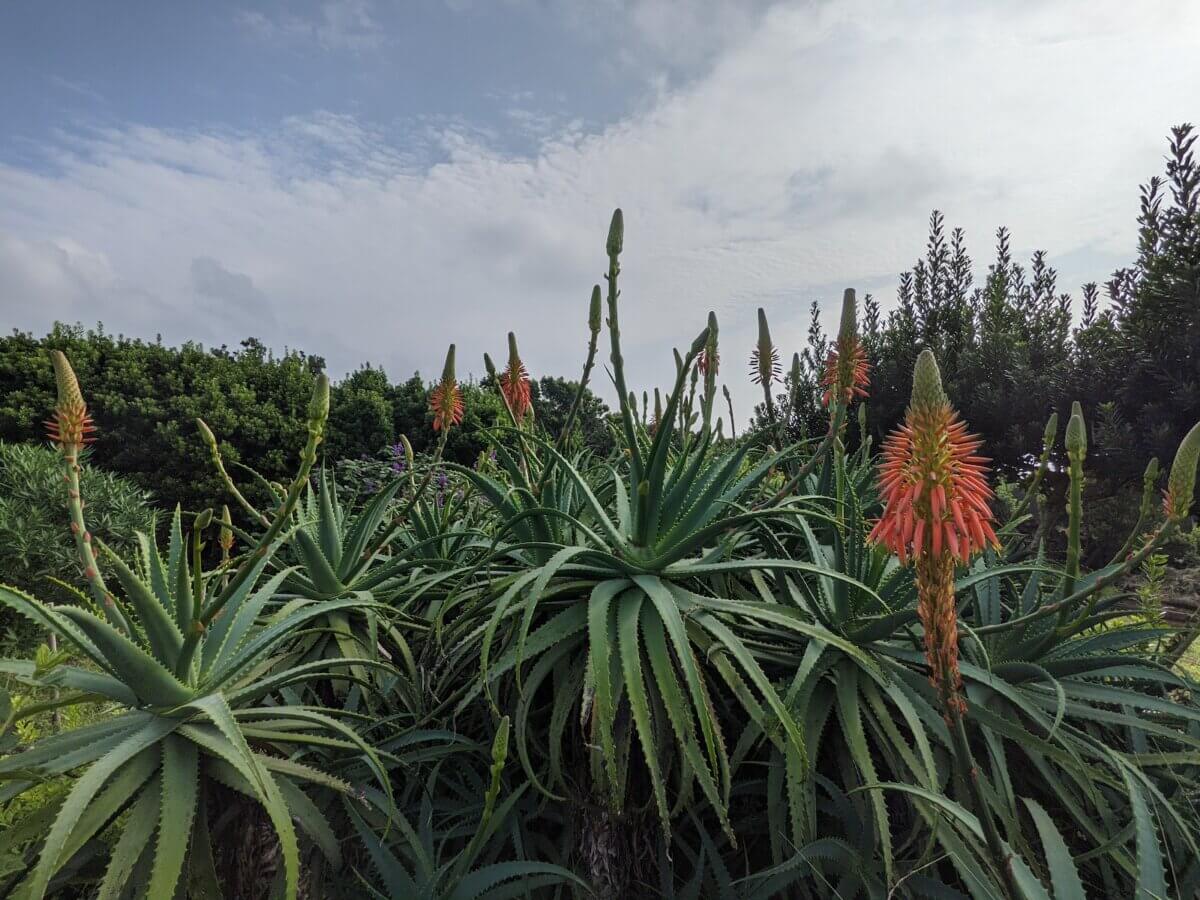
How Does One Ethically Harvest From an Aloe Vera Plant?
To ethically harvest, you make sure to only harvest what the plant is capable of giving without killing it or causing it to become fatally ill. When harvesting from an Aloe vera plant, you first examine the size of the plant.
- If you deem the plant to be large and abundant, you may harvest upward of 3 to 4 entire leaves at once.
- However, if you find the plant to be rather small, you may only take one whole leaf, or none at all.
- Unfortunately, there is no scientific or mathematical formula to follow here and it truly requires your best judgement. Hopefully the following pictures will help you better understand.
Related Post: How To Grow Healthy Aloe Vera
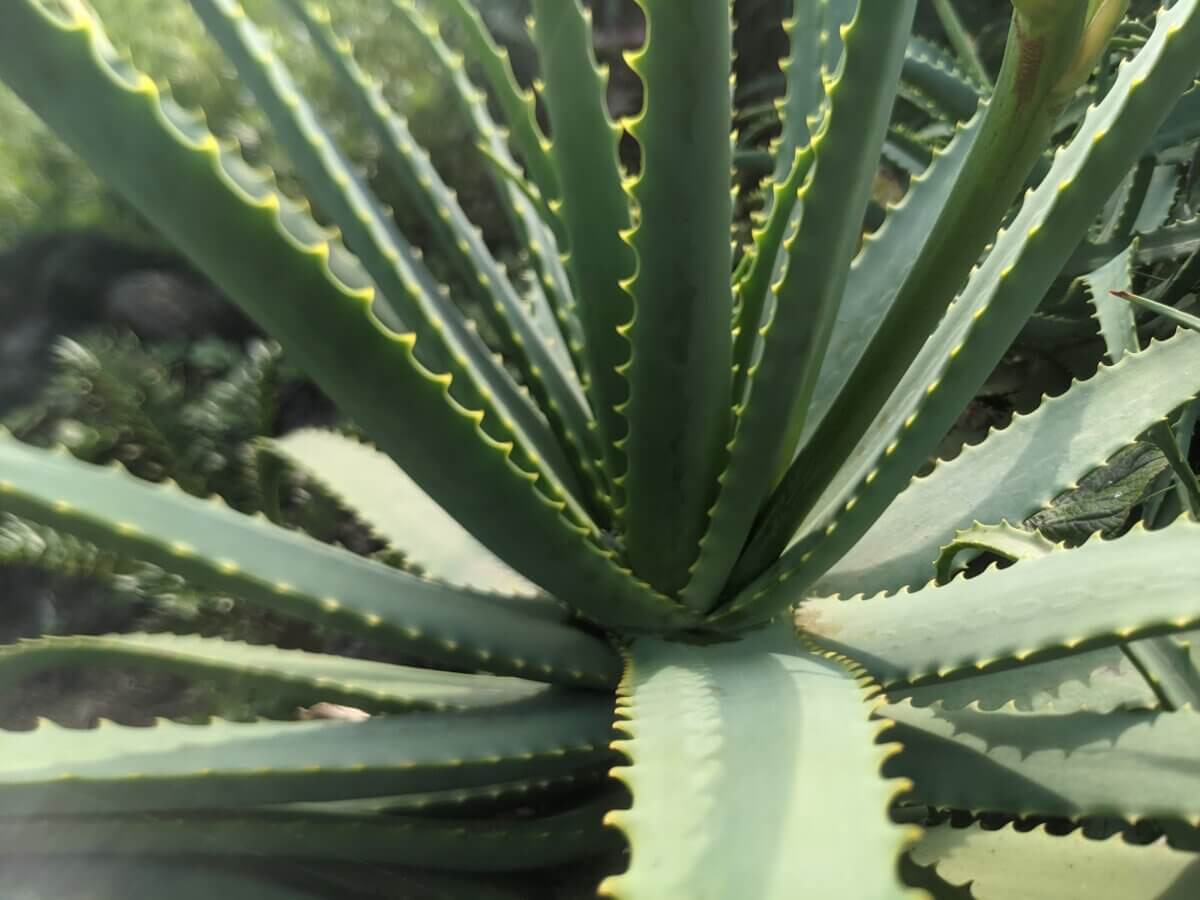
If you have a larger Aloe vera and you can harvest more leaves, ensure that you are taking leaves from multiple sides of the plant. You don’t want to take four leaves from the same section of the plant as this greatly increases the chances of infection. It is easier for the plant to lose leaves from multiple areas and helps minimize the chances of infection and accelerate healing.
If you have a large Aloe vera, you may believe you can take more than four leaves, and this may be true. However, I would advise taking leaves on a rotation and harvesting four leaves the first day, and (after the plant has had a few days to recover and close off the fresh wounds from where you harvested) then take more. This allows the plant to undergo less stress and ensures an easier time healing.
Another factor involved when selecting leaves to harvest is the actual size of the leaves. Having a large Aloe plant doesn’t necessarily mean the leaves are ready to be harvested. Generally, younger leaves will have light-colored streaks or spots on them, while older leaves will be solid in color, or fading from light to dark with different shades of greens and yellows. You want to avoid any leaves that still have the spotting or streaking; these leaves are too young to harvest.
Next, you are looking for leaves that are both wide and thick. The width should ideally be 3 plus finger-widths wide, and the thickness has no specified perimeters except there should be a “squish factor.” If you lightly squeeze the leaf, it should be soft and allow you to squish it a little. This means it is ready and ripe enough to be harvested. If it is hard, and you are unable to squish it without a more forceful squeeze, it is not ripe enough to be harvested. Think about a mango or avocado, you don’t want to eat hard mangoes or avocados – plump and squishy ones are what you want.
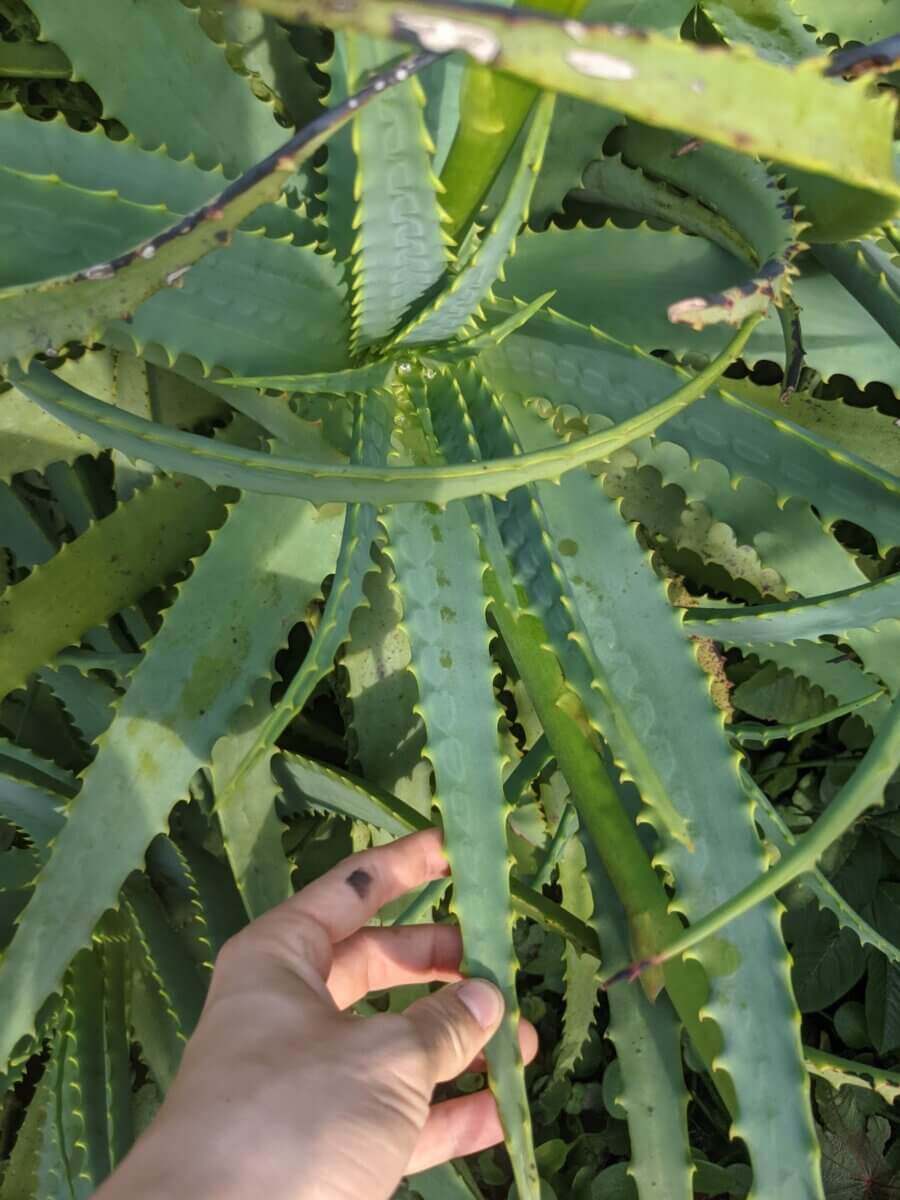
Another aspect of ethically harvesting to help minimize harm is that you harvest with a clean tool, and make a clean, straight cut at the base of the leaf as close to the center of the plant as you can get. Jagged cuts do not allow for optimal recovery, just as smooth cuts on human skin tend to heal better and quicker than jagged ones (same same, but different).
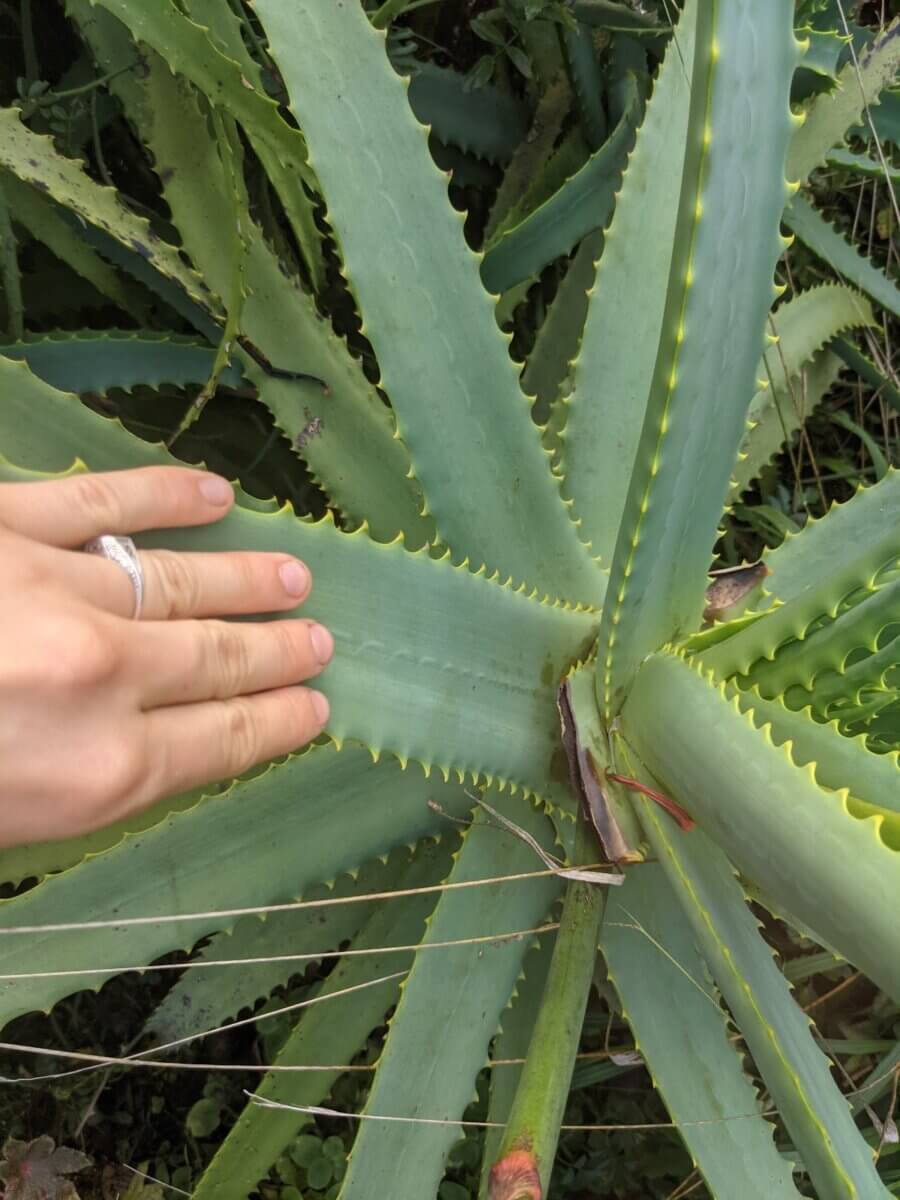
You will find when you harvest Aloe vera that it actually cuts easily, and therefore, any smooth, clean tool can work well to do this. No special tools needed. Cutting as close as possible to the base of the leaf you to get the most gel you can, as larger quantities of gel are found lower down in the leaf.
Immediately after harvesting the leaves, you should place them so the base is facing down. Aloe vera contains aloin, which is a quite bitter and potent natural laxative I would advise against ingesting. You will notice after you harvest the Aloe vera that yellow liquid will begin draining out. This is the aloin.
Placing the leaves with the base down helps the aloin to drain. I have placed them on rocks with minimal dirt present, hung them on clothes lines, put them in large containers to help them stay standing (sometimes, containers with water). The water seems to help pull the aloin out quicker. Regardless, allow the Aloe vera to drain for at least 30 minutes.
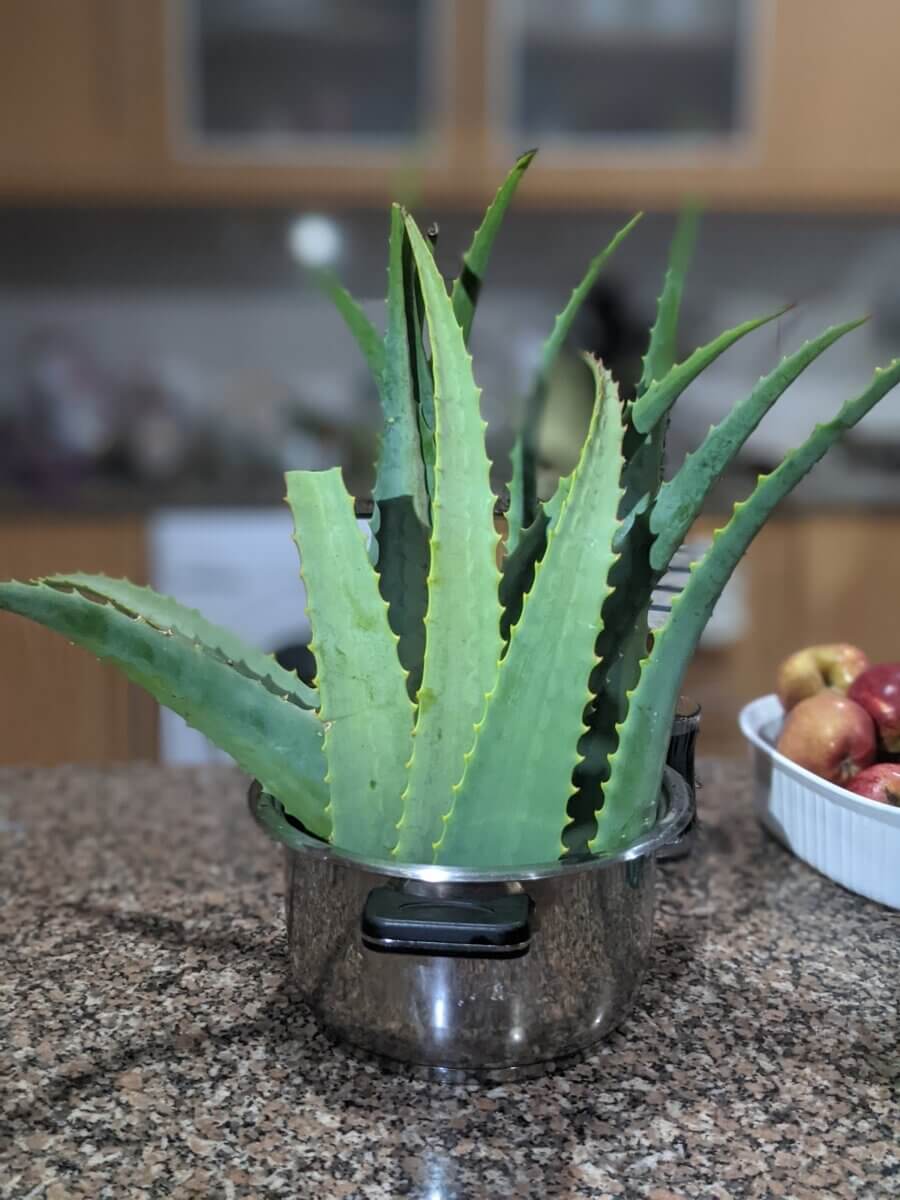
Processing Aloe Vera
Next, prepare to begin processing the Aloe vera leaves and harvest the gel. To do this, ensure you have these items present.
- Cutting board or a surface that’s equivalent
- Sharp, nonserrated knife
- Large bowl filled with water
- Sink/drainage/rinsing station
- Compost bin
- Spoon
1. Chopping the tips
Chop off the tip of the Aloe vera leaf, as well as the base where the initial cut was made (residual aloin that has not drained will usually stick here). Discard top and bottom in the compost bin.
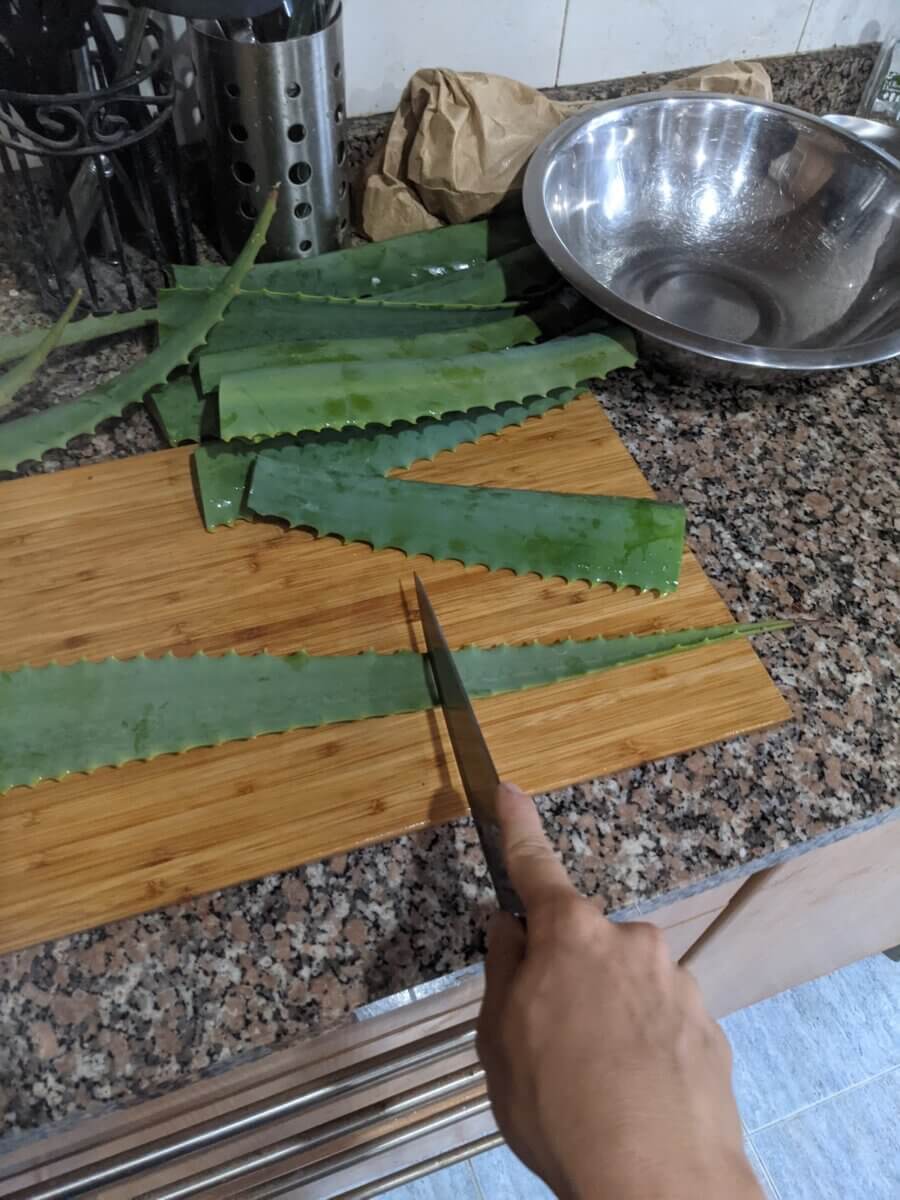
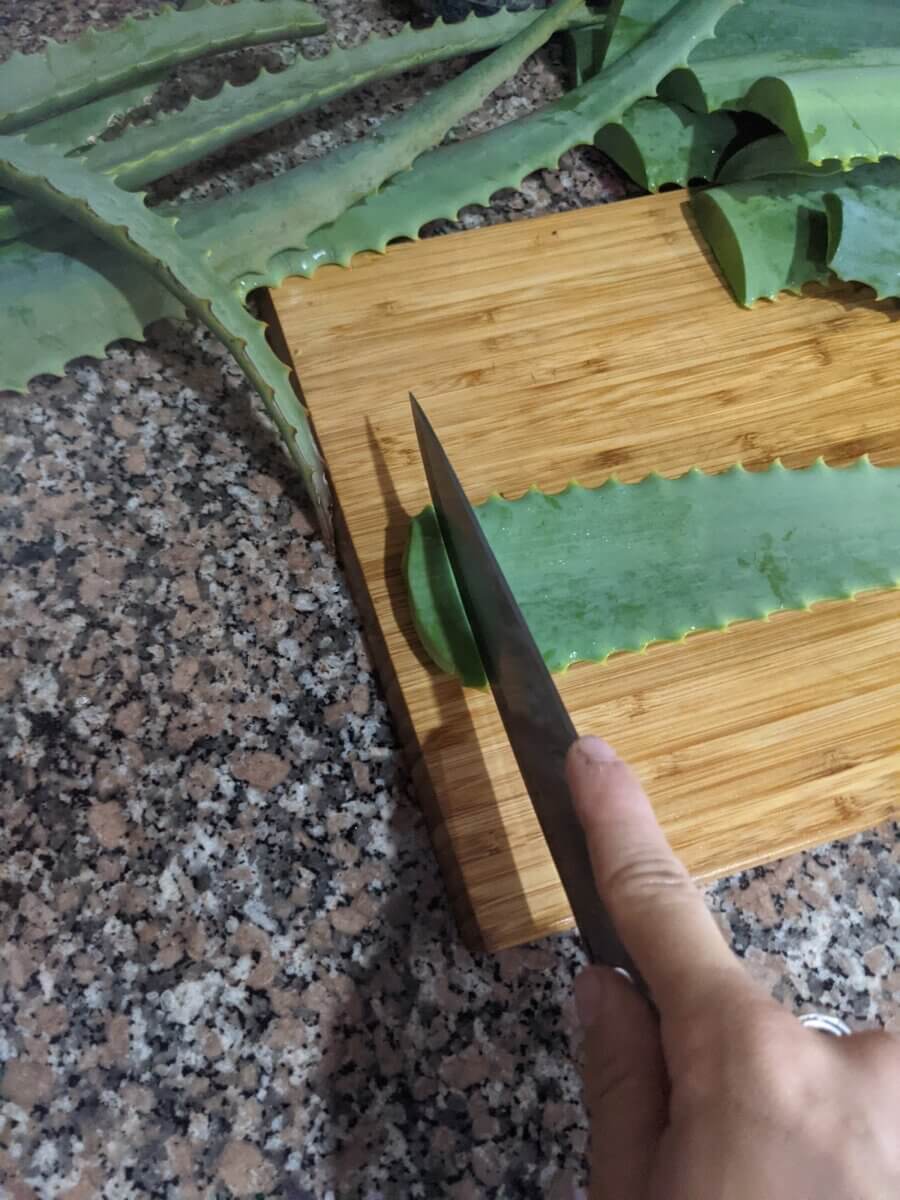
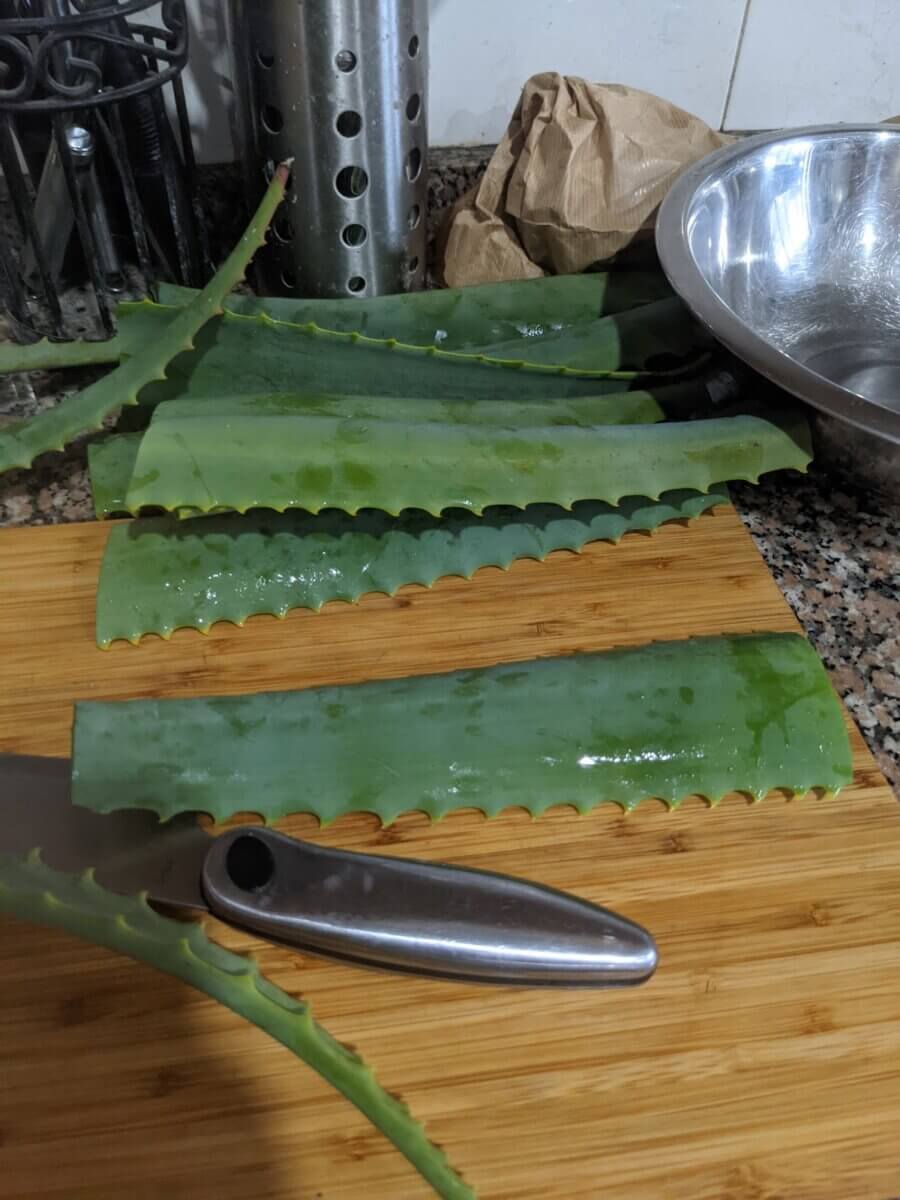
2. Section the leaf
Cut the leaf into 2 or 3 sections, depending on the length of the leaf (use your best judgment, as always).
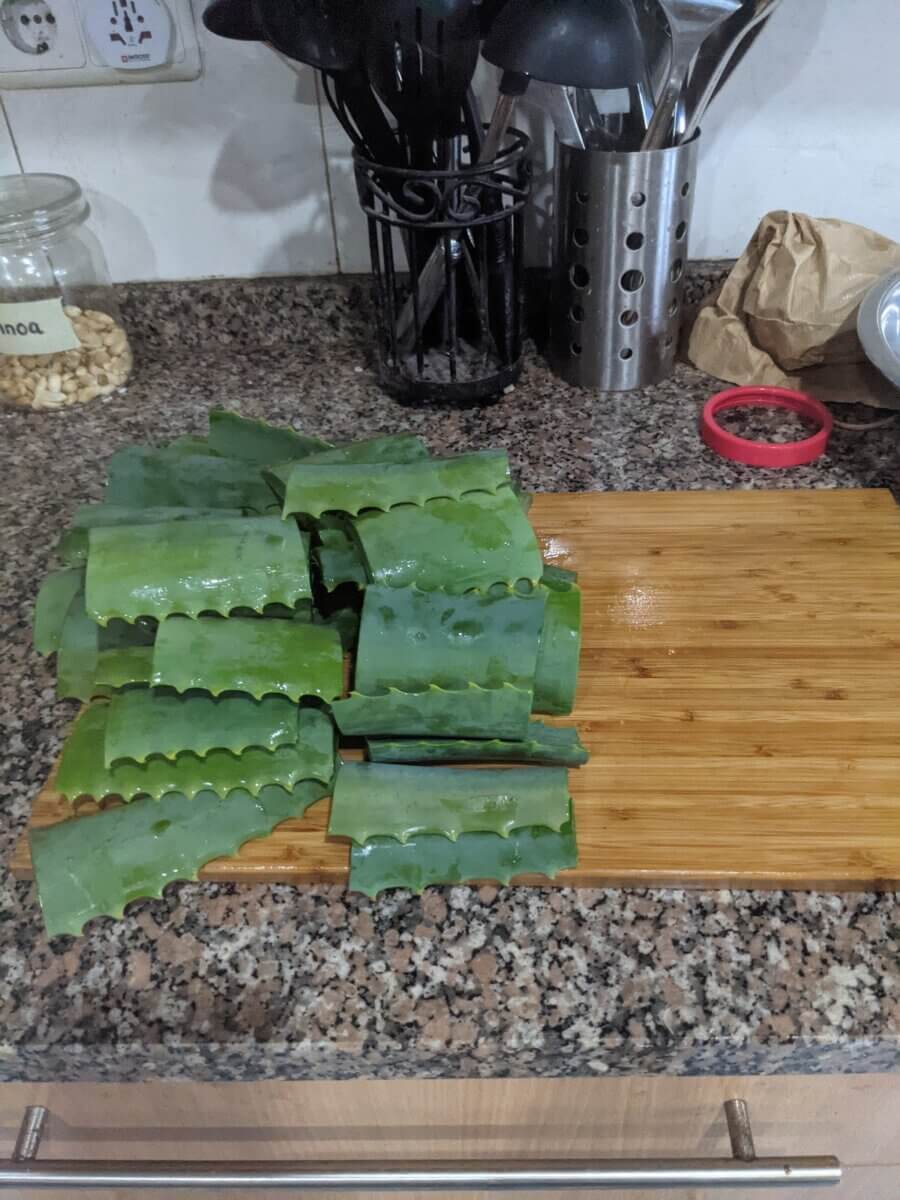
3. Cut the serrated edges
Cut off the serrated edges, being careful to cut as close to the edge as possible. This is in an effort to keep as much of the Aloe vera gel in the leaf as possible.
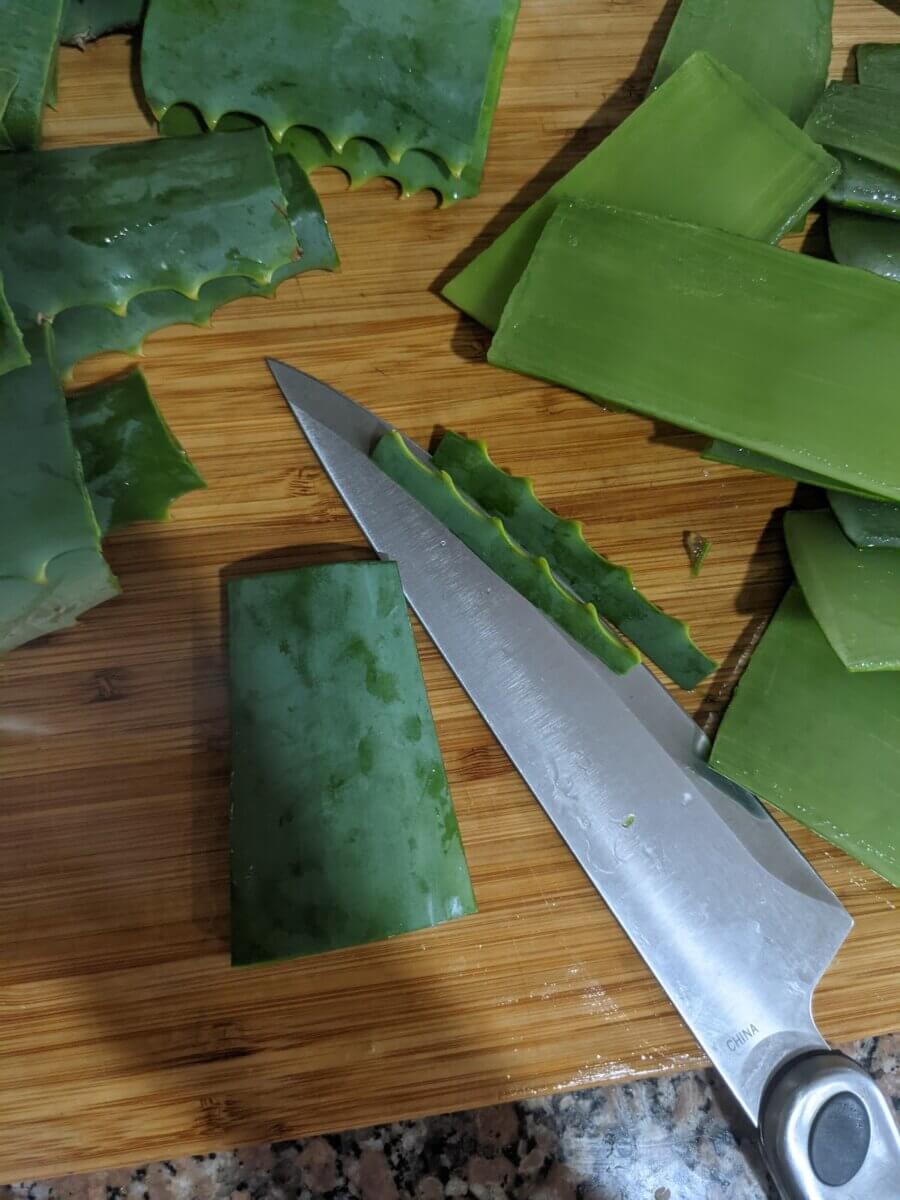
4. Slice the layer of green skin off the flat side
You will notice the bottom side of the leaf is smooth, while the top side that faces the sun is rounded. Slice the layer of green skin off the flat side, holding the leaf as seen in this picture. Try to cut as close to the green skin as possible to minimize any clear gel being cut off with the skin. Discard the skin in the compost bucket.
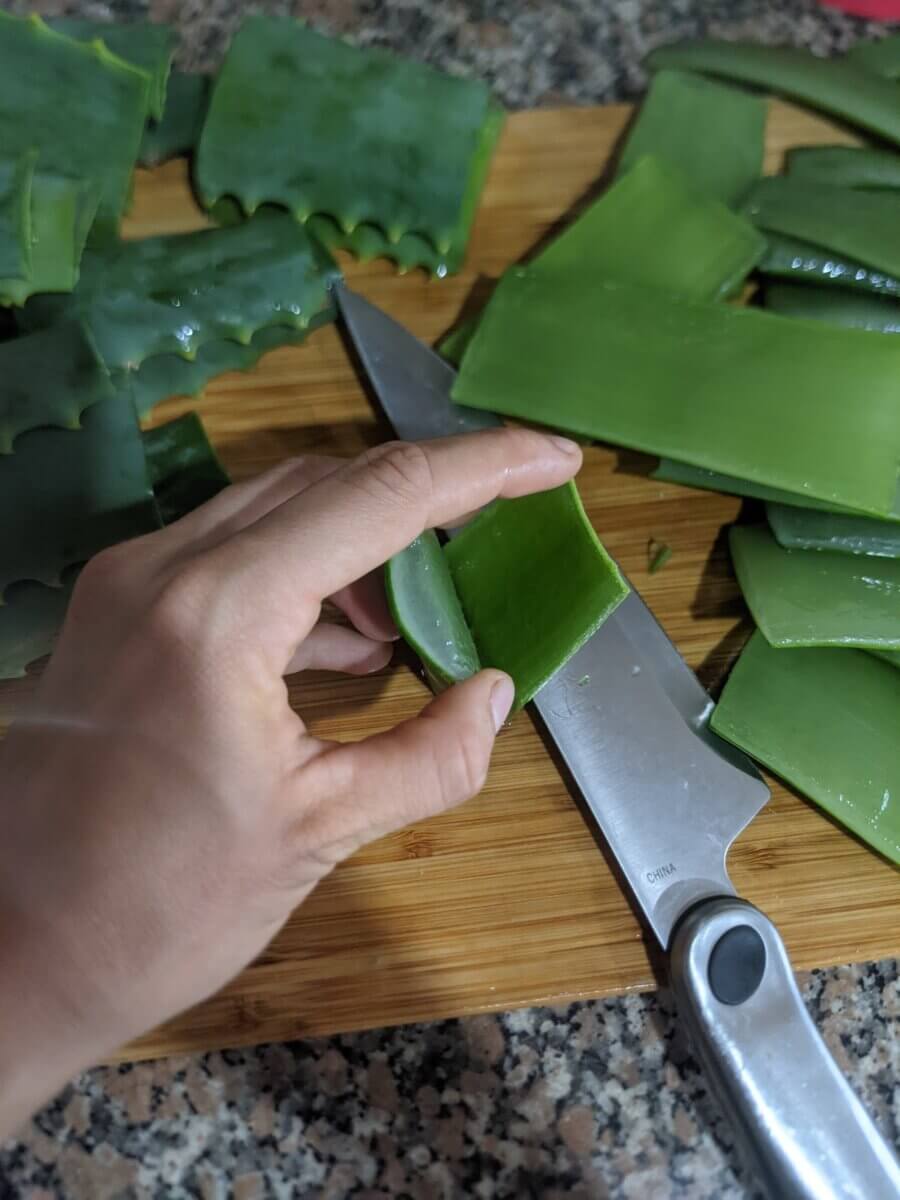
5. Scrape the aloe
Using the spoon, scrape the clear Aloe vera gel off the remaining green skin.
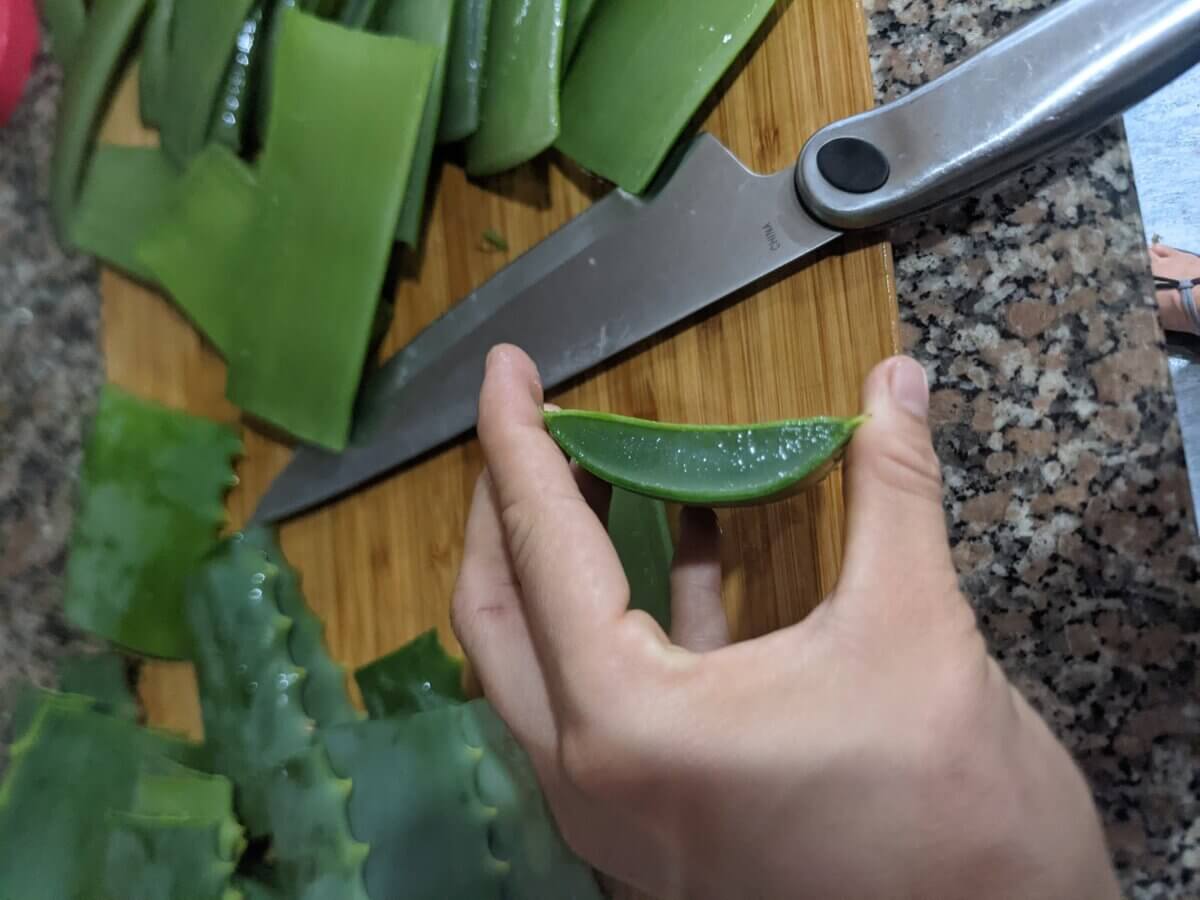
Important to note! When cutting off the bottom, flat skin, try to ensure there are no green or yellow fibers still attached to the gel. If there are, remove them from the gel as well. Likewise, when scraping gel off the remaining skin, don’t scrape so hard that the green-yellow fibers come off with it. The green-yellow fibers will contain aloin which you want to avoid as much as possible.
Another fun thing to note and try! Taste the Aloe vera gel during the process. Again, I wouldn’t recommend tasting the aloin as it is dripping, but taste the gel as you scoop it off the remaining skin. It will likely be very bitter.
The last step is simply rinsing the freshly harvested gel a few times. There will be obvious pieces of gel present, as well as essentially invisible slime. Try not to rinse the slime down the sink. The slime is good! You want to keep that.
After you have rinsed it a few times, try tasting it again (it may still be bitter). For safe measure (even if it is not bitter) allow Aloe vera to soak overnight in water in a refrigerator or closed container. Then rinse again the following morning. Continue taste testing until bitterness is gone.
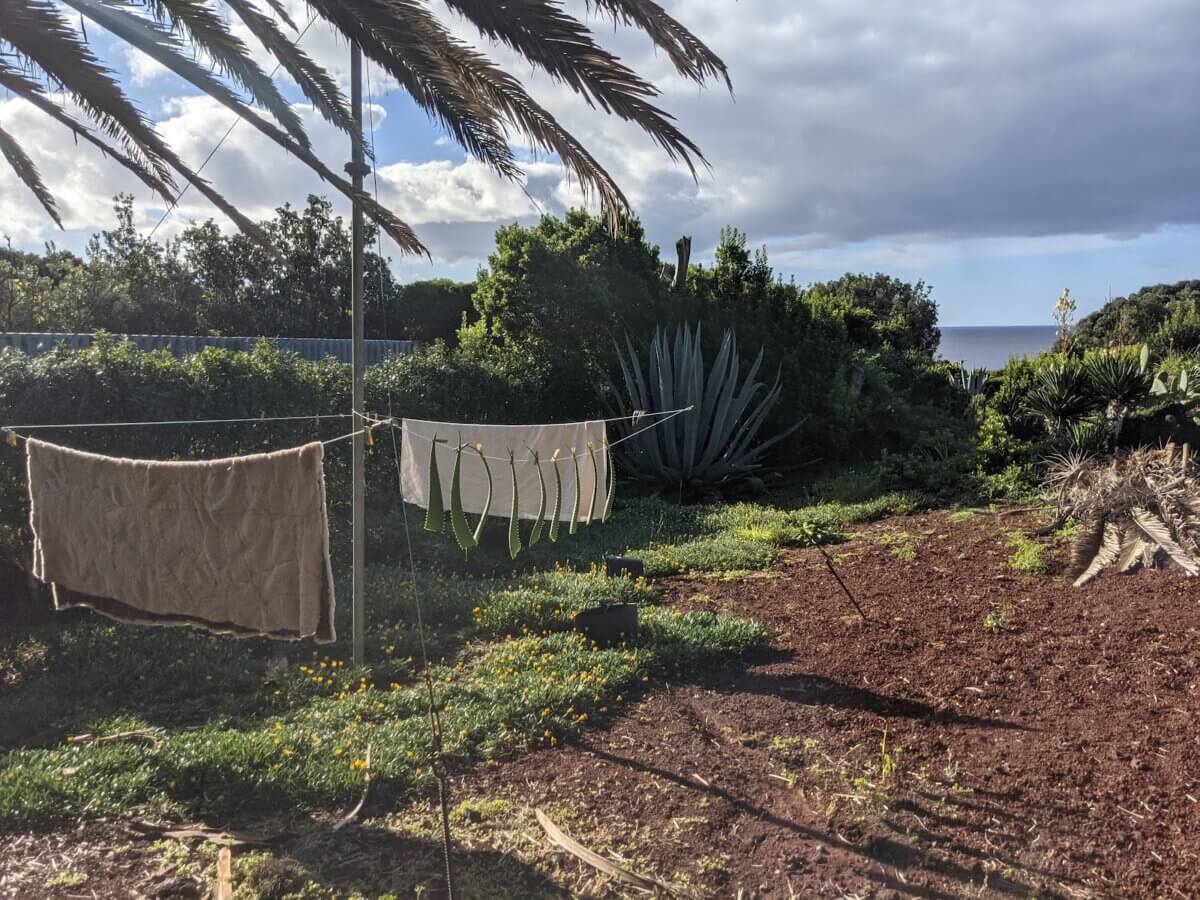
Aloe Vera Uses & Benefits
Now that you have the gel, what do you do with it? How can you use it? Why would you want to use it? What are the benefits?
There are two uses of Aloe vera gel (that I know of).
Topical Use
Because of its antioxidant and antibacterial properties, Aloe vera gel is excellent in treating numerous skin ailments. It helps accelerate healing and prevent infection. You can use Aloe vera gel to treat sunburns, canker sores, acne, eczema, psoriasis, and wrinkles if applied topically. Aloe vera gel may also provide temporary pain relief from sunburns and canker sores. It is said if swished in the mouth, it can help reduce dental plaque.
Essentially, once you have processed your Aloe vera gel, it is ready to be applied topically. You may prefer to blend it to help remove the larger chunks of gel leftover and allow for a smoother application. You may also choose to mix it with organic coconut oil to make a lotion.
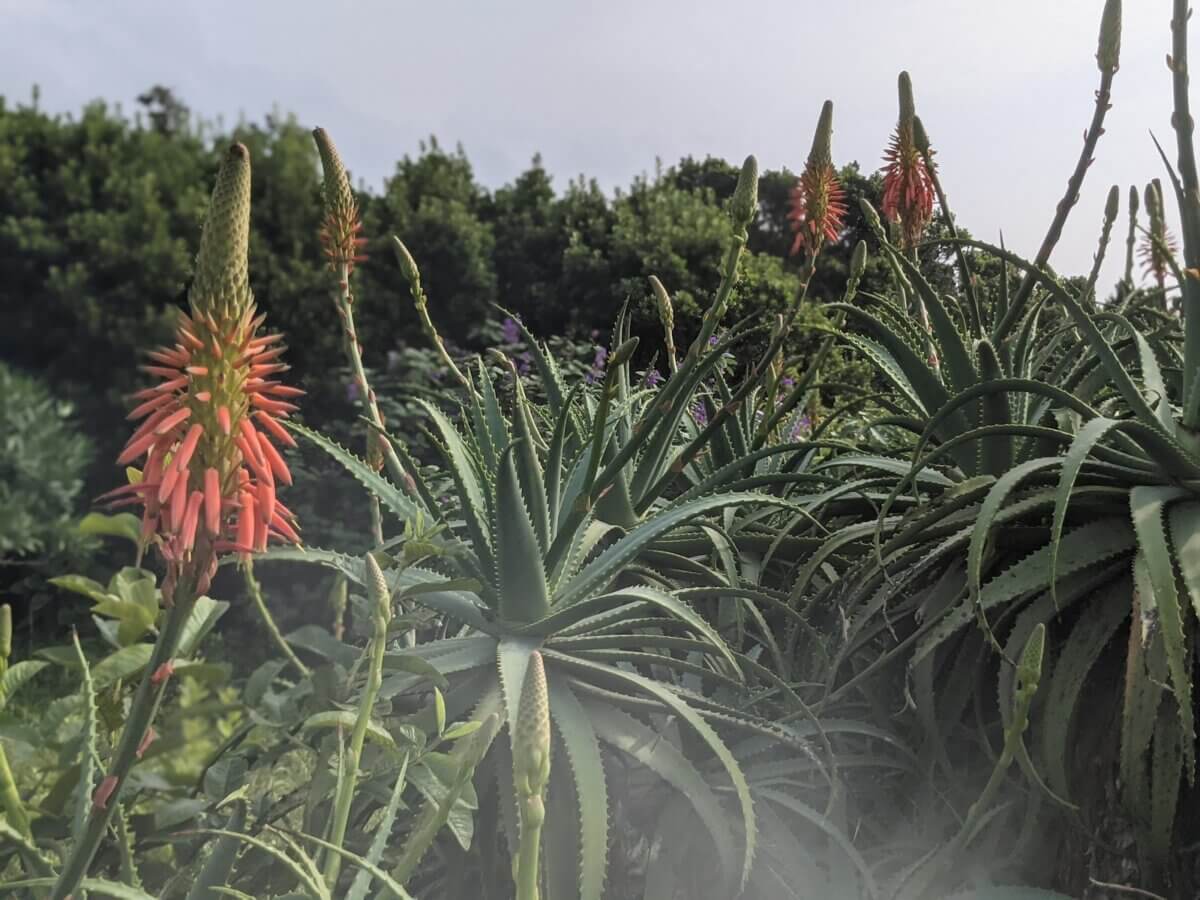
Ingestional Use
Because of the aloin present, Aloe vera can help alleviate digestive issues, particularly constipation. Aloin acts as a natural laxative. It is not helpful or advised to drink pure aloin. The previously described process tries to reduce the presence of aloin by repeated washings. Ingesting the final product after most of the aloin has been washed away is okay. The trace amounts of aloin can help alleviate mild constipation. Also, the antibacterial and antioxidant properties of Aloe vera gel help to provide relief from a wide variety of digestive issues. It is also said that Aloe vera can help reduce blood sugar levels.
You can ingest the processed gel as is. The taste is that of water with slight bitterness. Or, you can lightly batter it in sugar (even a lemon sugar mixture) and freeze it to have as a healthy-ish frozen treat. Personally, I have blended it and made Aloe vera mint lemonade. Blending the gel into smoothies is also a nice way to ingest it.
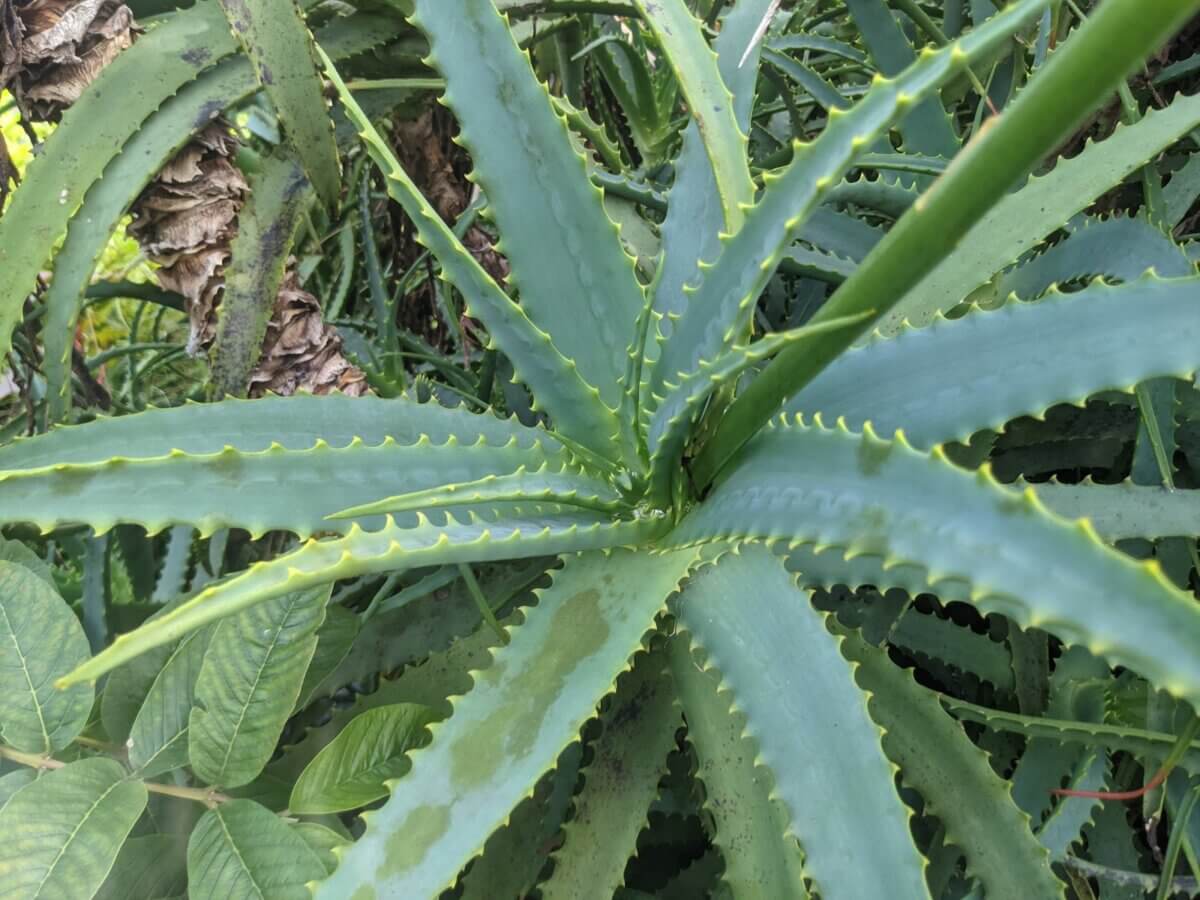
* Not all of these uses and benefits have been FDA approved or scientifically proven, most are home remedies recommended by herbalists. They are homeopathic remedies. Try under your own advisement and risk.
I personally have tried aloe vera gel to treat sunburns and acne, and provide relief from constipation, and have found it to be helpful for all of these. While it is widely accepted that Aloe vera gel aids in sunburn relief, it is not as commonly known that it helps alleviate mild constipation issues. It could be the placebo effect of me having believed it would help, but regardless, I found it very useful.










































Leave a Reply